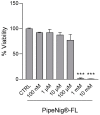PipeNig®-FL, a Fluid Extract of Black Pepper (Piper Nigrum L.) with a High Standardized Content of Trans-β-Caryophyllene, Reduces Lipid Accumulation in 3T3-L1 Preadipocytes and Improves Glucose Uptake in C2C12 Myotubes
- PMID: 31731718
- PMCID: PMC6893583
- DOI: 10.3390/nu11112788
PipeNig®-FL, a Fluid Extract of Black Pepper (Piper Nigrum L.) with a High Standardized Content of Trans-β-Caryophyllene, Reduces Lipid Accumulation in 3T3-L1 Preadipocytes and Improves Glucose Uptake in C2C12 Myotubes
Abstract
Trans-β-caryophyllene (BCP) is a natural sesquiterpene hydrocarbon with several important pharmacological activities, including antioxidant, anti-inflammatory, anticancer, and cardioprotective functions. These properties are mainly due to its selective interaction with the peripherally expressed cannabinoid receptor 2. In addition, BCP activates peroxisome proliferated activator receptors α and γ and inhibits the Toll-like receptor signaling pathway. Given the growing scientific interest in BCP, the aim of our study was to investigate the metabolic effects of a black pepper extract (PipeNig®-FL), containing a high standardized content of BCP. In particular our interest was focused on its potential activity on lipid accumulation and glucose uptake. The extract PipeNig®-FL was chemically characterized by gas chromatography-mass spectrometry (GC-MS) and gas chromatography with flame-ionization detection (GC-FID), confirming a high content (814 mg/g) of BCP. Experiments were performed on 3T3-L1 preadipocytes and on C2C12 myotubes. Lipid content following 3T3-L1 adipogenic differentiation was quantified with AdipoRed fluorescence staining. Glucose uptake and GLUT4 membrane translocation were studied in C2C12 myotubes with the fluorescent glucose analog 2-NBDG and by immunofluorescence analysis. Here we show that PipeNig®-FL reduces 3T3-L1 adipocyte differentiation and lipid accumulation. Moreover, acute exposure of C2C12 myotubes to PipeNig®-FL improves glucose uptake activity and GLUT4 migration. Taken together, these results reveal interesting and novel properties of BCP, suggesting potential applications in the prevention of lipid accumulation and in the improvement of glucose uptake.
Keywords: GLUT4; adipogenesis; black pepper; glucose uptake; lipid accumulation; trans-β-caryophyllene.
Conflict of interest statement
MEM is also currently a fellow of the Biosfered Srl company. No patents are pending and Biosfered supported the study by providing PipeNig®-FL and other chemical reagents and partly supporting the research. Biosfered did not interfere with the design, analysis, and decision to publish this paper. The remaining authors declare that the research was conducted in the absence of any commercial or financial relationships that could be construed as a potential conflict of interest.
Figures






Similar articles
-
Plant-Derived Trans-β-Caryophyllene Boosts Glucose Metabolism and ATP Synthesis in Skeletal Muscle Cells through Cannabinoid Type 2 Receptor Stimulation.Nutrients. 2021 Mar 12;13(3):916. doi: 10.3390/nu13030916. Nutrients. 2021. PMID: 33809114 Free PMC article.
-
Gly-Ala-Gly-Val-Gly-Tyr, a novel synthetic peptide, improves glucose transport and exerts beneficial lipid metabolic effects in 3T3-L1 adipoctyes.Eur J Pharmacol. 2011 Jan 10;650(1):479-85. doi: 10.1016/j.ejphar.2010.10.006. Epub 2010 Oct 14. Eur J Pharmacol. 2011. PMID: 20951125
-
Suppression of adipocyte differentiation and lipid accumulation by stearidonic acid (SDA) in 3T3-L1 cells.Lipids Health Dis. 2017 Sep 25;16(1):181. doi: 10.1186/s12944-017-0574-7. Lipids Health Dis. 2017. PMID: 28946872 Free PMC article.
-
β-caryophyllene and β-caryophyllene oxide-natural compounds of anticancer and analgesic properties.Cancer Med. 2016 Oct;5(10):3007-3017. doi: 10.1002/cam4.816. Epub 2016 Sep 30. Cancer Med. 2016. PMID: 27696789 Free PMC article. Review.
-
A focused review on CB2 receptor-selective pharmacological properties and therapeutic potential of β-caryophyllene, a dietary cannabinoid.Biomed Pharmacother. 2021 Aug;140:111639. doi: 10.1016/j.biopha.2021.111639. Epub 2021 Jun 3. Biomed Pharmacother. 2021. PMID: 34091179 Review.
Cited by
-
Plant Natural Sources of the Endocannabinoid (E)-β-Caryophyllene: A Systematic Quantitative Analysis of Published Literature.Int J Mol Sci. 2020 Sep 7;21(18):6540. doi: 10.3390/ijms21186540. Int J Mol Sci. 2020. PMID: 32906779 Free PMC article.
-
In Vivo Hypoglycemic Effects, Potential Mechanisms and LC-MS/MS Analysis of Dendropanax Trifidus Sap Extract.Nutrients. 2021 Nov 30;13(12):4332. doi: 10.3390/nu13124332. Nutrients. 2021. PMID: 34959884 Free PMC article.
-
Shift of Volatile Organic Compounds (VOCs) in Gluten-Free Hemp-Enriched Sourdough Bread: A Metabolomic Approach.Nutrients. 2020 Apr 10;12(4):1050. doi: 10.3390/nu12041050. Nutrients. 2020. PMID: 32290149 Free PMC article.
-
Beta-Caryophyllene Modifies Intracellular Lipid Composition in a Cell Model of Hepatic Steatosis by Acting through CB2 and PPAR Receptors.Int J Mol Sci. 2023 Mar 23;24(7):6060. doi: 10.3390/ijms24076060. Int J Mol Sci. 2023. PMID: 37047034 Free PMC article.
-
Plant-Derived Trans-β-Caryophyllene Boosts Glucose Metabolism and ATP Synthesis in Skeletal Muscle Cells through Cannabinoid Type 2 Receptor Stimulation.Nutrients. 2021 Mar 12;13(3):916. doi: 10.3390/nu13030916. Nutrients. 2021. PMID: 33809114 Free PMC article.
References
-
- Silva Figueiredo P., Inada A.C., Ribeiro Fernandes M., Granja Arakaki D., Freitas K.D.C., Avellaneda Guimarães R.D.C., Aragão do Nascimento V., Aiko Hiane P. An Overview of Novel Dietary Supplements and Food Ingredients in Patients with Metabolic Syndrome and Non-Alcoholic Fatty Liver Disease. Molecules. 2018;23:877. doi: 10.3390/molecules23040877. - DOI - PMC - PubMed
MeSH terms
Substances
Grants and funding
LinkOut - more resources
Full Text Sources
Miscellaneous

